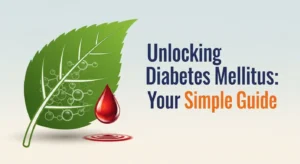Introduction
For people with diabetes, the body can't use sugar for energy. Instead, it starts burning fat, which creates harmful acids called ketones. When these ketones build up too much, it leads to a serious diabetic ketoacidosis symptoms called Diabetic Ketoacidosis, or DKA.

Diabetic ketoacidosis symptoms is a life-threatening emergency that needs quick medical help. But here's the tricky part: many early or mild DKA symptoms can be easy to miss. They might seem like everyday aches, a common stomach bug, or just feeling a bit “off.” Because these subtle signs can be overlooked, DKA can become much more dangerous before anyone realizes what's happening.
This article will help you understand what DKA is, what the common symptoms are, and most importantly, shine a light on those sneaky symptoms that are often missed. Knowing these signs can make all the difference in getting help quickly and staying safe. Let's dive in!
DKA Symptom Checker
Check the boxes next to any symptoms you are currently experiencing. This tool is for informational purposes only and does not replace professional medical advice.
Key Takeaways
- DKA is a Medical Emergency: It happens when your body lacks insulin, causing harmful acids (ketones) to build up. It needs immediate medical attention.
- Beyond Obvious Signs: While extreme thirst and fruity breath are known, DKA can start with subtle symptoms like mild stomach upset, unusual tiredness, or headaches.
- Mimics Common Illnesses: Early DKA symptoms can feel like the flu or a stomach bug, making them easy to dismiss.
- Test for Ketones: If you have diabetes and your blood sugar is high or you feel unwell, it's crucial to test for ketones.
- Act Fast, Stay Safe: Don't wait for severe symptoms. If you suspect DKA, especially with high blood sugar, seek medical help right away.
What is Diabetic Ketoacidosis Symptoms (DKA)?
To really understand DKA, let's break down how your body normally works. Your body needs energy to do everything, from thinking to running. It gets this energy mainly from a type of sugar called glucose, which comes from the food you eat.
Insulin is a hormone, like a tiny key, that helps glucose move from your bloodstream into your body's cells. Think of your cells as little engines that need glucose as fuel.
For people with diabetes, this system doesn't work perfectly:
- Type 1 Diabetes: The body doesn't make insulin at all.
- Type 2 Diabetes: The body either doesn't make enough insulin, or the insulin it does make doesn't work well (this is called insulin resistance).
When your body can't get glucose into its cells, your cells are “starving” for energy, even though there might be plenty of glucose in your blood. This is why blood sugar levels go very high in diabetes.
To find energy, your body then turns to burning fat instead. When fat is broken down for energy, it produces waste products called ketones. Ketones are acidic. If too many ketones build up in your blood, your blood becomes acidic, leading to acidosis. This whole process is DKA. It's a dangerous situation because too much acid in your blood can harm your organs, leading to coma or even death if not treated quickly.
Common Diabetic Ketoacidosis Symptoms (The Obvious Ones)
When DKA gets more severe, the symptoms become quite clear. These are the signs that often prompt people to seek emergency care.
Classic DKA Warning Signs:
- Extreme Thirst: You might feel like you can't drink enough water.
- Frequent Urination: Because your body tries to get rid of extra sugar and ketones through urine, you'll be going to the bathroom a lot.
- High Blood Sugar: Your glucose monitor will show very high readings.
- Nausea, Vomiting, or Abdominal Pain: Feeling sick to your stomach, throwing up, or having belly pain.
- Fruity-Smelling Breath: This is a very specific sign! Ketones, specifically acetone, can make your breath smell like nail polish remover or rotten fruit.
- Confusion or Difficulty Concentrating: Your brain isn't getting enough energy, making it hard to think clearly.
- Weakness and Tiredness: Feeling very weak, drained, and having no energy.
These symptoms are important to know, but relying only on them can be risky. DKA doesn't always start with all these blaring alarms.

The Easy-to-Miss Diabetic Ketoacidosis Symptoms
Now, let's talk about the symptoms that often fly under the radar. These are the ones that can be mistaken for other, less serious conditions, delaying crucial treatment. Being aware of these subtle signs is key to early detection.
1. Subtle Stomach Issues: Not Just a Tummy Ache
Many people associate DKA with severe abdominal pain. However, it can start with much milder stomach upset:
- Mild Nausea: Just feeling a bit queasy, not necessarily throwing up.
- Loss of Appetite: Not wanting to eat, even if you usually enjoy food.
- General Stomach Discomfort: A vague feeling of unease or bloating in your belly, rather than sharp pain.
These can easily be dismissed as a minor stomach bug, indigestion, or just feeling unwell after eating something.
2. Fatigue and Weakness (Beyond Normal Tiredness)
We all get tired, but DKA fatigue is different. It's a deep, persistent exhaustion that doesn't go away with rest.
- Unusual Tiredness: Feeling more tired than usual, even if you've slept well.
- Lack of Energy: Struggling to do daily tasks that are normally easy.
- General Malaise: A feeling of being unwell, run down, or just “not right.”
This can be mistaken for stress, lack of sleep, or the start of a cold.
3. Muscle Aches or General “Flu-like” Feeling
Before the full-blown DKA symptoms hit, some people report feeling like they're coming down with the flu.
- Body Aches: Aches and pains in your muscles, similar to what you feel with a viral infection.
- Chills (without fever): Feeling cold even when it's warm, without a high temperature.
- Overall “Sick” Feeling: Just a general sense of feeling unwell, without clearly defined symptoms.
This is a classic example of how DKA can trick you into thinking it's just a common bug.
4. Headaches: More Than Just a Bad Day
Persistent or worsening headaches can be a sign of DKA, especially if they don't respond to typical pain relievers.
- Dull, Persistent Ache: A headache that lingers and doesn't seem to go away.
- Worsening Headaches: Headaches that become more severe over time.
Because headaches are so common, they are often overlooked as a potential DKA symptom.
5. Changes in Breathing: The Silent Gasps
This is one of the most critical “easy-to-miss” symptoms because it's so unique to DKA but can be misinterpreted. It's called Kussmaul breathing.
- Deep, Rapid Breathing: You might find yourself breathing very deeply and quickly, almost as if you've just run a race, even when you're resting.
- Air Hunger: Feeling like you can't get enough air, even though you're breathing fast.
People might mistake this for anxiety, hyperventilation, or simply being out of breath. However, it's your body's way of trying to get rid of the acid buildup by exhaling more carbon dioxide.
6. Mood Changes or Irritability
DKA can affect your brain and mood, leading to subtle changes in behavior.
- Unexplained Mood Swings: Feeling unusually irritable, grumpy, or emotional.
- Difficulty Concentrating: Even more than the general confusion, you might find it hard to focus on tasks or conversations.
- Lethargy: A state of sluggishness and indifference.
These changes might be attributed to stress, lack of sleep, or other personal issues rather than a medical emergency.
7. Dry Mouth and Skin (Subtle Dehydration)
While extreme thirst is a common DKA symptom, you might first notice more subtle signs of dehydration.
- Persistent Dry Mouth: Your mouth feels dry even after drinking water.
- Dry Skin: Your skin might feel unusually dry or lose some of its elasticity.
These can be easily dismissed as not drinking enough water or just having dry weather.
8. Unexplained Weight Loss
If your body can't use glucose for energy, it starts breaking down fat and muscle. This can lead to noticeable weight loss, even if you're not trying to lose weight.
- Rapid Weight Loss: Losing weight quickly without any changes to your diet or exercise routine.
This might initially seem like a positive change, especially if you're concerned about your weight. However, unexplained weight loss, especially for someone with diabetes, should always be checked by a doctor. Maintaining a healthy weight is vital for managing diabetes and preventing complications like DKA. Explore topics like a 3-day fast for weight loss or Liv Pure reviews for insights into weight management strategies.

Why Are These Symptoms Missed?
It's easy to wonder why such serious symptoms could be overlooked. Several factors contribute to this:
- They Mimic Other Common Illnesses: As we've seen, many early DKA signs can be mistaken for the flu, a stomach bug, or just everyday stress. Who hasn't felt tired or had a headache?
- Gradual Onset: DKA often doesn't hit you like a ton of bricks. It can develop over several hours or even a day or two, making the symptoms seem less urgent at first.
- Lack of Awareness: Many people, especially those newly diagnosed with diabetes or who don't fully understand their condition, might not know what DKA is or what its early signs look like.
- Ignoring Mild Symptoms: We often try to “tough it out” when we feel a little unwell, hoping it will pass. With DKA, waiting can be dangerous.
- Focus on “Normal” Diabetes Symptoms: People with diabetes are used to monitoring blood sugar. They might not immediately connect vague feelings of unwellness with a serious complication like DKA, especially if their blood sugar isn't extremely high yet.
💡 Pull Quote: “The danger of DKA lies not just in its severity, but in its ability to masquerade as something far less threatening.”
Who is at Risk?
While DKA can affect anyone with diabetes, some groups are at higher risk:
- People with Type 1 Diabetes: This is the most common group affected because their bodies produce little to no insulin. If they miss insulin doses, get sick, or their insulin pump fails, DKA can develop rapidly.
- People with Type 2 Diabetes: While less common, Type 2 diabetics can also get DKA, especially if they have a severe infection, are very stressed, or their body is under unusual strain and cannot produce enough insulin.
- Newly Diagnosed Diabetics: Sometimes, DKA is the first sign that someone has diabetes, particularly Type 1 diabetes. Their body hasn't been making insulin for a while, and ketones have built up unnoticed.
- Anyone with an Infection or Illness: When you're sick, your body releases hormones that can raise blood sugar, making it harder for insulin to work. This increases DKA risk.
- People who Miss Insulin Doses: For those who rely on insulin, skipping even one dose can be enough to trigger DKA.
- People on Certain Medications: Some medications, like SGLT2 inhibitors (used for Type 2 diabetes), can increase the risk of diabetic ketoacidosis symptoms even with normal or slightly elevated blood sugar levels.

When to Seek Immediate Medical Help
Knowing the symptoms is only half the battle; knowing when to act is the other. Diabetic ketoacidosis symptoms (DKA) is a medical emergency. Don't try to treat it at home.
Seek immediate medical help if you experience:
- Any combination of the common or easy-to-miss Diabetic ketoacidosis symptoms.
- High blood sugar levels (e.g., above 250 mg/dL or 13.9 mmol/L) that don't come down with extra insulin.
- Moderate to large amounts of ketones in your urine or blood (as tested with ketone strips or a blood ketone meter).
- Persistent nausea, vomiting, or abdominal pain.
- Fruity-smelling breath.
- Confusion, drowsiness, or difficulty staying awake.
- Deep, rapid breathing.
When in doubt, check it out! It's always better to be safe than sorry. A quick trip to the emergency room or urgent care can save your life. Tell the medical staff you have diabetes and suspect DKA.
Preventing Diabetic Ketoacidosis Symptoms (DKA): Your Action Plan
The best way to deal with DKA is to prevent it from happening in the first place. Here's how:
- Manage Your Diabetes Well:
- Monitor Blood Sugar Regularly: Check your blood sugar often, especially when you're sick or stressed.
- Take Insulin as Prescribed: Never skip or reduce your insulin doses without talking to your doctor. Even if you're not eating, your body still needs insulin.
- Follow Your Meal Plan: Try to stick to your diabetes meal plan to help keep blood sugar stable.
- Know Your Sick Day Rules:
- Work with your doctor to create a “sick day plan.” This plan tells you how to adjust your insulin, what to eat, and how often to check your blood sugar and ketones when you're ill.
- Test for Ketones: This is crucial! If your blood sugar is high (e.g., over 250-300 mg/dL or 13.9-16.7 mmol/L) or you feel unwell, test your urine or blood for ketones. Ketone strips are available at pharmacies. If ketones are present, especially in moderate or large amounts, follow your sick day plan or seek medical attention.
- Stay Hydrated: Drink plenty of sugar-free fluids, especially when your blood sugar is high or you're sick. This helps your kidneys flush out excess sugar and ketones.
- Educate Yourself: Learn as much as you can about diabetes and its complications. Understanding the signs of diabetic ketoacidosis symptoms, especially the subtle ones, empowers you to act quickly.
- Consult Your Doctor Regularly: Keep up with your regular doctor appointments. Discuss any concerns, new symptoms, or difficulties you're having with your diabetes management. Just as it's important to monitor DKA symptoms, staying on top of other health aspects, like prostate health, is crucial. You can learn more about prostate supplements and effective prostate supplements for men, or read a Prostavive review to understand different options.
By being proactive and informed, you can significantly reduce your risk of diabetic ketoacidosis symptoms and ensure you get the care you need if symptoms appear. Your health is in your hands! 👋

Conclusion
Diabetic Ketoacidosis Symptoms (DKA) is a very serious complication of diabetes that requires immediate medical attention. While some DKA symptoms are well-known and obvious, many early signs are subtle and easy to miss. These include mild stomach upset, unusual tiredness, muscle aches, headaches, changes in breathing, mood swings, and unexplained weight loss.
By understanding these “hidden” diabetic ketoacidosis symptoms and knowing when to test for ketones, you can catch DKA early and get the life-saving treatment you need. Always remember that if you have diabetes and feel unwell, especially with high blood sugar, it's safer to check for ketones and contact your healthcare provider. Your awareness and quick action can make all the difference in staying healthy and safe. Take charge of your health and be vigilant!








